
- Usage in publication:
-
- Cheesequake Formation*
- Modifications:
-
- Named
- Biostratigraphic dating
- Dominant lithology:
-
- Sand
- Clay
- AAPG geologic province:
-
- Atlantic Coast basin
Summary:
Named the Cheesequake Formation for Cheesequake Park, Middlesex Co., NJ. In surface exposures, consists of intercalated, thin to laminated, dark-gray, micaceous weathering, light tan clay or clayey silt with abundant woody fragments and light, fine-grained micaceous sand. Unit is about 13 meters thick in outcrop. Unconformably overlies the Magothy Formation and unconformably underlies the Merchantville Formation. In the subsurface of NJ, unit consists of a thin basal, dark greenish gray, clayey, fine-grained, quartz glauconitic sand, a thick, dark gray, micaceous, very clayey silt to very fine quartz sand, and an upper thin, clayey, fine-grained, quartz sand. Thickness in the subsurface is up to 35 meters. Unconformably overlies the Magothy Formation and unconformably underlies cycle Kc1. Unit does not crop out south of the type locality, but is widespread in the subsurface in both the central and southern bedrock maps. The Cheesequake is of Late Cretaceous (late Santonian to early Campanian) age based on nannofossil and pollen biostratigraphy.
Source: GNU records (USGS DDS-6; Reston GNULEX).
For more information, please contact Nancy Stamm, Geologic Names Committee Secretary.
Asterisk (*) indicates published by U.S. Geological Survey authors.
"No current usage" (†) implies that a name has been abandoned or has fallen into disuse. Former usage and, if known, replacement name given in parentheses ( ).
Slash (/) indicates name conflicts with nomenclatural guidelines (CSN, 1933; ACSN, 1961, 1970; NACSN, 1983, 2005, 2021). May be explained within brackets ([ ]).

